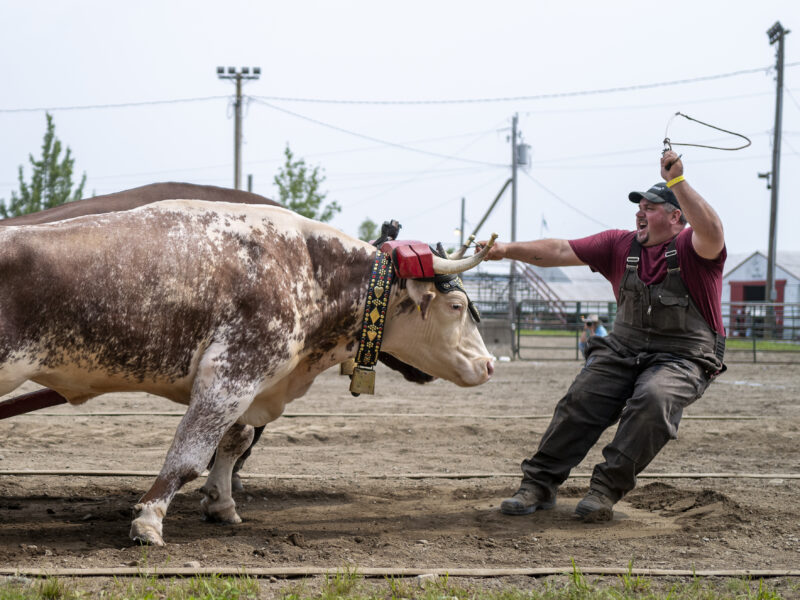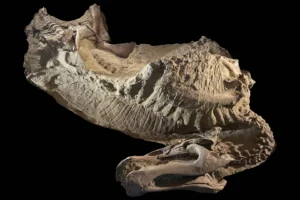Nova Scotia: Most Come for the Lobster, I Came for the Oxen
- Published In: Other News & Features
- Last Updated: Aug 18, 2023

A farmer and his two oxen compete in the ox pull semi-finals at the Bridgewater Big Ex in Nova Scotia. (Wyoming Truth photo by Matt Stirn)

By Matt Stirn
Special to the Wyoming Truth
The farmer stared into the eyes of his two oxen silently encouraging them. With his hands resting on both of their horns, he whispered, “Let’s go boys,” before releasing an echoing cry, instantly transforming his docile giants into determined pulling machines. Stacked behind them on a sled was a five-foot-tall pile of concrete blocks pushing 9,000 pounds. To win the International Ox Pull Competition at the South Shore Exhibition in Bridgewater, Nova Scotia, the team would need to drag the mega-load just another few feet. As the farmer yelled encouragement, the straining oxen snorted their understanding, the crowd cheered with eager anticipation and the champion title inched closer. Four feet to the finish line….three feet….two feet!

The South Shore Exhibition, locally known as The Big Ex, began in the summer of 1891 near the southwestern coast of Nova Scotia. First organized to celebrate the bustling Nova Scotian farming community, the annual event continues to promote local agricultural traditions through exhibits, demonstrations and coveted competitions, including the horse pull, oxen pull and a variety of show horse events. One hundred and thirty-two years ago when the Big Ex first began, teams of oxen and gigantic draft horses were commonplace on farms throughout the Canadian province that relied on the animals to till the rich, but rocky coastal soil. Even as motorized tractors and plows became readily available in the early 20th century, draft teams continued to be preferred; they could more flexibly navigate the hilly and boulder ridden fields which proved troublesome to modern equipment. While farming continues to play a major role throughout Nova Scotia, the traditional pulling teams have largely transitioned from work to leisure animals who are specifically raised to compete in pulling competitions across the region. At the 2023 exhibition, foresters, cod fisherman and lobster boat captains alike brought their expertly trained gentle giants to vie for the championship pull.
In my youth, the Teton County Fair in Jackson was where our community gathered and celebrated its western heritage and rural roots. Each summer as fair season approached, my family and I would prepare our entries (and boast our wins, like my grand champion peanut brittle), participate in 4-H competitions such as horse showmanship or riflery and volunteer in setting up the exhibit hall and manning the Wilson Homemakers’ scone booth. Jackson transformed over the years, with condos and shopping centers replacing pasture fields and art boutiques replacing family-owned shops. The county fair always was a refuge, an entity resistant to change, where for a brief week each summer, Jackson felt like the small quiet town I remember.
The crowd erupted in applause as the winning team triumphantly crossed the white finish line in the dirt arena. Knowing their job was done, the oxen relaxed and the farmer lovingly patted their heads. The draft horse pull would start in an hour, leaving me just enough time to devour a plate of fried Digby clams and see the winners of the home-grown produce competition. I had never attended a fair outside of Jackson, much less outside the United States, so I was surprised and excited by the familiarity of community and history as I explored the exhibition grounds. Change is just as inevitable in Atlantic Canada as it is in Jackson Hole, and it is comforting to know that each community has its bastion of tradition and nostalgia where snorting oxen, neighing horses and the aroma of fried dough can momentarily cloak the issues and stresses of today.













